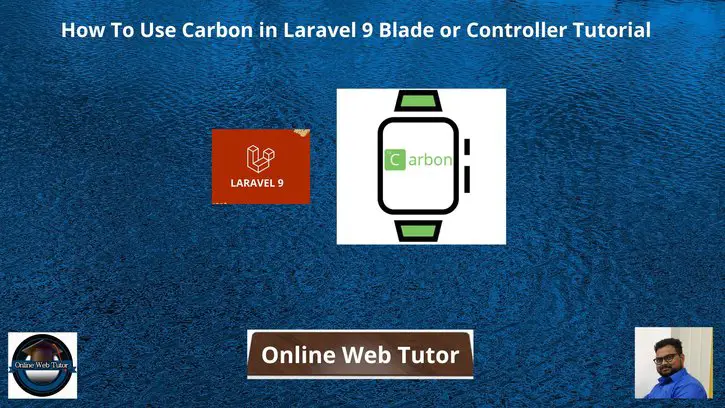Inside this article we will see the concept i.e How To Use Carbon in Laravel 9 Blade or Controller Tutorial. Article contains the classified information about Using Carbon in Laravel blade template files or controller.
If you are looking for a solution i.e How to use carbon in Laravel 9 blade then this article will help you a lot for this. Tutorial is super easy to understand and implement it in your code as well.
The Carbon package can be used for many purposes, such as reading the current date and time, changing the default date and time format, finding the difference between two dates, converting the date and time from one timezone to another timezone, etc.
Learn More –
- How To Convert URL encoded String To PHP Array Tutorial
- CodeIgniter 4 How To Use Froala WYSIWYG HTML Editor Tutorial
- CodeIgniter 4 Drag and Drop Reorder Items with jQuery
- Laravel 9 Autocomplete Places Search Box Using Google Maps JavaScript API
Let’s get started.
Laravel Installation
Open terminal and run this command to create a laravel project.
composer create-project laravel/laravel myblogIt will create a project folder with name myblog inside your local system.
To start the development server of laravel –
php artisan serveURL: http://127.0.0.1:8000
Assuming laravel already installed inside your system.
How To Use Carbon in Controller
To understand the use of Carbon in controller, Let’s consider a laravel controller of your application.
Usage
<?php
namespace App\Http\Controllers;
use Illuminate\Http\Request;
use App\Models\User;
use Carbon\Carbon;
class UserController extends Controller
{
/**
* Write code on Method
*
* @return response()
*/
public function index(Request $request)
{
$now = Carbon::now()->format('m/d/Y');
print($now);
$user = User::where('id',1)->first();
$userCreatedTime = Carbon::parse($user->created_at)->format('m/d/Y');
dd($userCreatedTime);
}
}
Concept
To get current date in format:
$now = Carbon::now()->format('m/d/Y');Parse a date using Carbon:
Assuming $user->created_at gives the date of registered user,
Carbon::parse($user->created_at)->format('m/d/Y');Output
09/12/2022
09/08/2022How To Use Carbon in Blade
To understand the use of Carbon in blade template, Let’s consider a laravel template of your application.
Usage
@inject('carbon', 'Carbon\Carbon')
<!DOCTYPE html>
<html>
<head>
<title>How To Use Carbon in Laravel Blade File</title>
</head>
<body>
<p>{{ $carbon::parse('2022-09-12')->format('m/d/Y') }}</p>
</body>
</html>
Concept
In Laravel, dependency injection is the process of injecting class dependencies into a class through a constructor or setter method.
@inject('carbon', 'Carbon\Carbon')Parse a date using Carbon:
{{ $carbon::parse('2022-09-12')->format('m/d/Y') }}Output
09/12/2022How To Use Carbon in Model
To understand the use of Carbon in Model, Let’s consider a laravel model of your application.
<?php
namespace App\Models;
//...
use Carbon\Carbon;
class User extends Authenticatable
{
/**
* Write code on Method
*
* @return response()
*/
public function created_at_mdY()
{
return Carbon::parse($this->created_at)->format('m/d/Y');
}
}
Concept
Here, we have created a method in model. This method uses Carbon.
public function created_at_mdY()
{
return Carbon::parse($this->created_at)->format('m/d/Y');
} Next, we will call this model method into laravel controller.
<?php
namespace App\Http\Controllers;
use Illuminate\Http\Request;
use App\Models\User;
class UserController extends Controller
{
/**
* Write code on Method
*
* @return response()
*/
public function index(Request $request)
{
$user = User::where('id',1)->first();
dd($user->created_at_mdY());
}
}
Output
09/11/2022We hope this article helped you to learn How To Use Carbon in Laravel 9 Blade or Controller Tutorial in a very detailed way.
Online Web Tutor invites you to try Skillshike! Learn CakePHP, Laravel, CodeIgniter, Node Js, MySQL, Authentication, RESTful Web Services, etc into a depth level. Master the Coding Skills to Become an Expert in PHP Web Development. So, Search your favourite course and enroll now.
If you liked this article, then please subscribe to our YouTube Channel for PHP & it’s framework, WordPress, Node Js video tutorials. You can also find us on Twitter and Facebook.
